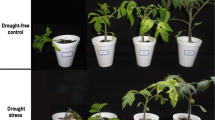Summary
Heat shock proteins (hsps) are synthesized at higher temperatures in soybean seedlings exposed to a gradual temperature increase as compared to a rapid heat shock (hs). There are differences in the pattern of synthesis of different hsps depending on whether the temperature exposure is rapid or gradual. The synthesis of normal temperature proteins also occurs at higher temperatures after a gradual increase in temperature than after a rapid hs. The increased protein synthesis seen with a gradual temperature increase is because of increased mRNA levels. In general the mRNAs for actin and the hsps are found at temperatures 6 to 9°C higher after a gradual temperature increase than after a rapid hs. While hsps are detected in developing seeds after either type of heat treatment an increase in the synthesis of hsps is observed at the higher temperatures after a gradual temperature increase compared to a rapid hs to the same temperatures. The only proteins synthesized at the highest temperatures (49°C) after a gradual temperature increase are the precursors of the storage proteins and the hsps. After a gradual increase in temperature the mRNAs for the 11S storage proteins are present in relatively large amounts up to 43°C decreasing thereafter but were detectable at 52°C; whereas, the hsp mRNA levels were relatively constant from 40 to 52°C.
Similar content being viewed by others
References
Alexandrov VY: Cells, Molecules and Temperature, Springer-Verlag, Berlin, 1977.
Altschuler M, Mascarenhas JP: Heat shock proteins and effects of heat shock in plants. Plant Mol Biol 1:103–115, 1982.
Dawson WD, Grantham GL: Inhibition of stable RNA synthesis and production of a novel RNA in heat-stressed plants. Biochem Biophys Res Comm 100:23–30, 1981.
Frankis RC, Mascarenhas JP: Messenger RNA in the ungerminated pollen grain: A direct demonstration of its presence. Ann Bot 45:595–599, 1980.
Goldberg DA: Isolation and partial characterization of the Drosophila alcohol dehydrogenase gene. Proc Nat Acad Sci USA 77:5794–5801, 1980.
Goldberg RB, Hoschek G, Ditta GS, Breidenbach RW: Developmental regulation of cloned superabundant embryo mRNAs in soybean. Develop Biol 83:218–231, 1980.
Key JL, Lin C-Y, Ceglarz E, Schoffl F: The heat shock response in plants: physiological considerations. In: Schlesinger MJ, Ashburner M, Tissieres A (eds) Heat Shock From Bacteria to Man. Cold Spring Harbor Lab, 1982, pp 329–336.
Lehrach H, Diamond D, Wozney JM, Boedtker H: RNA molecular weight determinations by gel electrophoresis under denaturing conditions: A critical re-examination. Biochem 16:4743–4754, 1977.
Levitt J: Responses of Plants to Environmental Stress, Vol 1. Chilling, Freezing and High Temperature Stresses. Academic Press, New York, 1980.
Lin C-Y, Roberts JK, Key JL: Acquisition of thermotolerance in soybean seedlings: Synthesis and accumulation of heat shock proteins and their cellular localization. Plant Physiol 74:152–160, 1984.
Machlis L, Torrey JG: Plants in Action. Freeman, San Francisco, 1956.
Maniatis T, Jeffrey DG, Kleid DG: Nucleotide sequence of the rightward operator of phage λ. Proc Nat Acad Sci USA 72:1184–1188, 1975.
Mascarenhas JP: Molecular mechanisms of heat stress tolerance. In: Collins GB, Petolino JG (eds) Applications of Genetic Engineering to Crop Improvement. Martinus Nijhoff/Dr W Junk Publ, Dordrecht, 1984, pp 391–425.
Mascarenhas JP, Altschuler M: Responses to environmental heat stress in the plant embryo. In: Walden DB, Atkinson BG (eds) Changes in Gene Expression in Response to Environmental Stress. Academic Press, 1985, pp 315–326.
Schoffl F, Key JL: An analysis of mRNAs for a group of heat shock proteins of soybean using cloned cDNAs. J Mol Appl Genet 1:301–314, 1982.
Shah DM, Hightower RC, Meagher RB: Complete nucleotide sequence of a soybean actin gene. Proc Nat Acad Sci USA 79:1022–1026, 1982.
Thomas PS: Hybridization of denatured RNA and small DNA fragments transferred to nitrocellulose. Proc Nat Acad Sci USA 77:5201–5205, 1980.
Yarwood CE: Adaptations of plants and plant pathogens to heat. In: Prosser CL (ed) Molecular Mechanisms of Temperature Adaptation, Amer Assoc Advancement Sci, Washington, DC, Publ No 84, 1967, pp 75–89.
Author information
Authors and Affiliations
Rights and permissions
About this article
Cite this article
Altschuler, M., Mascarenhas, J.P. Transcription and translation of heat shock and normal proteins in seedlings and developing seeds of soybean exposed to a gradual temperature increase. Plant Mol Biol 5, 291–297 (1985). https://doi.org/10.1007/BF00020626
Received:
Revised:
Accepted:
Issue Date:
DOI: https://doi.org/10.1007/BF00020626




